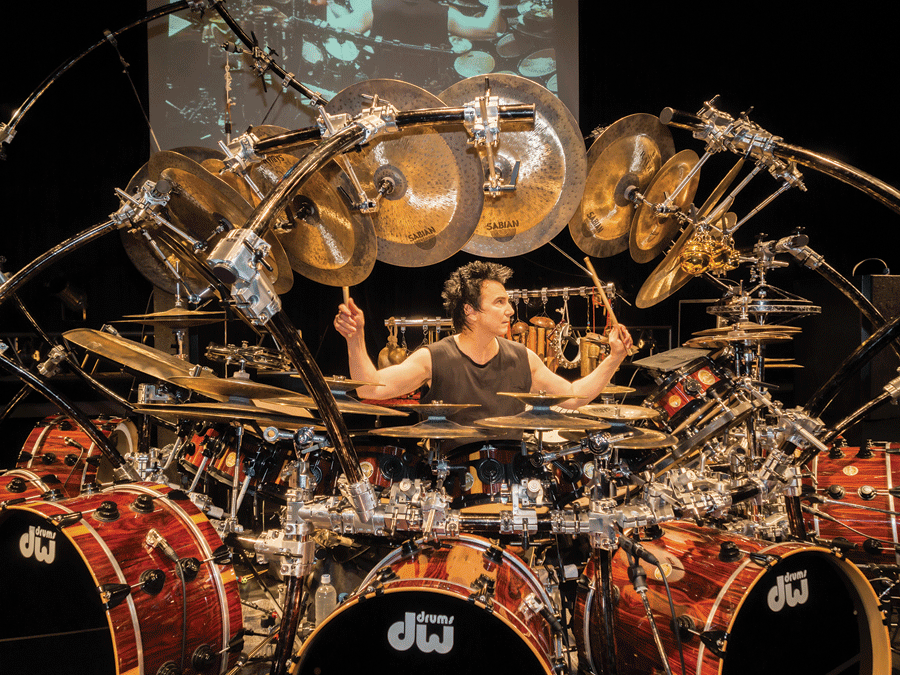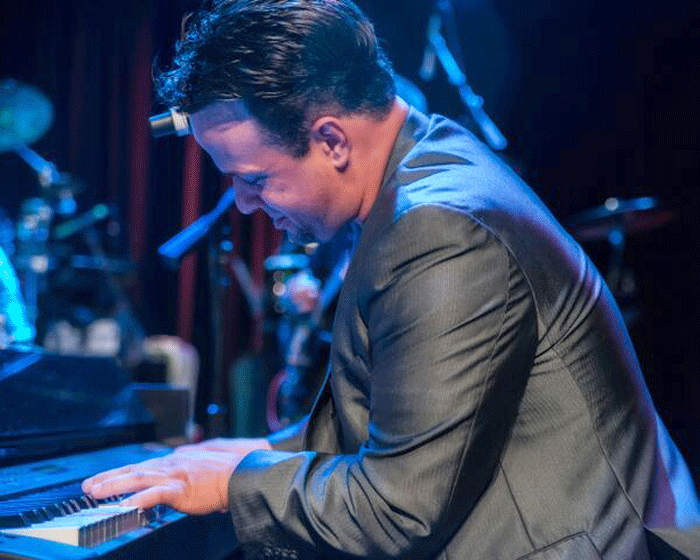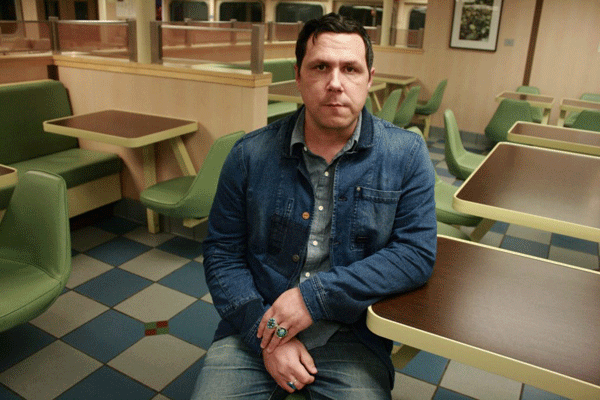Terry Bozzio, one of the world’s premier rock drummers, first learned about the power of music from an instrument that isn’t usually the instigator of many mystical, musical experiences: the accordion.
Bozzio’s father played that instrument in such a way that it changed people’s lives, according to the accordion player’s son.
“My father was a brilliant accordion player and was on stage by the age of four,” he said in a phone interview. “A prodigy. By the time I was a kid and he was in his 30s, people would come over to the house and ask him to pull out his accordion. He would always make excuses and say, ‘No, I ain’t got it anymore.’
“Finally, he’d break down and pull the thing out,” Bozzio said. “And he’d play one chord and silence the room. He could make people cry. When you’re a little kid and you see this power of music, it’s a very envious situation.”
Drums came into it for Bozzio the way that drums came into many boys’ lives in the 1950s and 1960s: through television.
Flashy percussionists like Gene Krupa, Buddy Rich and Lionel Hampton were all over the airwaves in those days. They were exciting to watch and much revered. It should be easy to understand why any boy growing up in the mid-20th century would develop an interest in pounding the skins, Bozzio said.
Or pounding the end tables.
A Tito Puente album purchased by Bozzio’s dad inspired him to transform a set of Heywood-Wakefield nesting tables (tables that fit together like nesting dolls) into bongos.
Bozzio said he still has those nesting tables, but don’t expect him to play them when he appears at GearFest, Sweetwater Sound’s annual showcase of music technology and the musical technicians that use it.
Bozzio will discuss drumming with DW owner John Good in a conversation moderated by Sweetwater’s Nick D’Virgilio in the Performance Theatre at 2:30 p.m. Friday, June 23.
Bozzio said the Beatles caused him to pursue music as a vocation rather than an avocation.
Just as the accordion isn’t the instrument most often associated with acclaimed music careers, it may be that Beatles drummer Ringo Starr isn’t the first person that virtuoso drummers cite as a primary influence.
But Bozzio said Starr’s drumming is underrated.
“I think Ringo was a very creative drummer in feel and with his beat designs,” he said. “He’s a special case because of his fame and influence. But even if I were to listen without that in mind, I would still think he is a very creative drummer. I would cite ‘Ticket to Ride,’ ‘Tomorrow Never Knows’ and ‘Anna’ as examples.”
Throughout his late teens and early 20s, Bozzio played mostly for jazz greats such as Joe Henderson, Eddie Henderson, Woody Shaw and Jack DeJohnette.
He also drummed for TV commercial soundtracks and Broadway musicals.
Then Bozzio was chosen over 100 other aspirants to join Frank Zappa’s band.
At 66, Bozzio can still say the Zappa audition was the toughest of his career.
According to the conventional wisdom among musicians at that point, playing with Zappa meant you could play with anyone, he said.
Bozzio said he became world-famous among music professionals and serious music aficionados within a week of being signed by Zappa. Zappa’s reputation conveyed instantaneous veneration.
There is no one who knew Zappa who disputes the following: He was a taskmaster who required perfection and who wasn’t really open to collaboration.
Bozzio said this was fine with him at the time.
“I always looked at it as ‘He’s the director and I’m the actor’ or ‘He’s the conductor and I am the musician in the orchestra,'” he said. “I was happy to have that kind of discipline. I was used to it. I really respected his genius.
“He was 10 years older than me and a serious genius in at least 10 talents,” Bozzio said. “He was a humorist and a writer. He was a classical composer. He was a bandleader. He was a rock star. He was an arranger. And he was a fantastic guitarist.
“This was a guy who I looked up to,” he said. “I was happy to take his orders and grow from that. It was like marine boot camp for a musician.”
The only disagreement Bozzio had with Zappa was provoked by the latter’s cynicism regarding the music business. Zappa believed a point had been reached where good music could not succeed, financially, on its own merits.
The music business had grown too corrupt, too addicted to bribery and backroom deals.
Bozzio said he still believed at the time that music could achieve grassroots success.
He eventually came to realize that Zappa had been right all along.
An apt encapsulation, in terms of weirdness and virtuosity, of Bozzio’s years with Zappa can be found on YouTube: a live performance of a song that we must euphemistically refer to here as “Breasts and Beer.”
Bozzio dons a devil mask and adopts a devilish persona during the segment.
Bozzio’s departure from Zappa’s band was like a father bird pushing a baby bird out of the nest, he said.
“He took me aside and said, ‘Bozzio, I think it’s time you go off and do your own thing. I don’t think you want to do this anymore.’ And I said the same thing I’d said when he offered me the job: ‘Do you really think I can do this?'”
Two years later, Bozzio founded (with his then-wife, Dale) the eighties pop group Missing Persons.
Thanks to catchy tunes and a sexy singer, the band was hugely successful, but it also benefited from debuting at roughly the same time as MTV.
In the beginning, MTV depended on those rare acts that had shot promotional videos for some unknown reason, and Missing Persons was one of those acts.
“We were on heavy rotation because MTV only had three videos,” Bozzio said, laughing.
The end of the band coincided with, and was inextricably linked to, the end of the Bozzios’ marriage.
In the years immediately after the dissolution of Missing Persons, Bozzio said he tried to remake himself into a pop soloist in the vein of Phil Collins.
But it didn’t feel natural.
He began to think in terms of “orchestral drumming,” featuring a drum set tuned in such a way that it could sound like an ensemble.
Nowadays, Bozzio tours the world giving solo drum concerts on his “big kit.” According to a 2014 article in the Cleveland Plain Dealer, the big kit consists of “26 toms, two snares, eight bass drums, 53 cymbals (including a ride gong), 22 pedals (which operate five hi-hats, a djembe, a foot cymbal, a jingle stick, rik, a tambourine, a foot tom, two ‘metal things’ and a foot gong), a xylophone, a glockenspiel, chromatic gongs, a ‘big’ gong, two electronic drums and miscellaneous percussion …”
The big kit won’t be making the trip to Fort Wayne, alas. Bozzio has a smaller version that he takes to clinics and workshops.
Bozzio said his solo drum tours do extremely well everywhere in the world but the United States.
Or the “culturally bankrupt United States,” as he puts it.
“I look to Europe and Japan, which are way more culturally open minded and have nice places to play,” he said. “Music seems to be something that’s a little more treasured there.
“I don’t blame the American people,” Bozzio said. “I blame dropping music in the schools and devaluing music completely. We’re all battling this.”
 Submit Your Event
Submit Your Event




